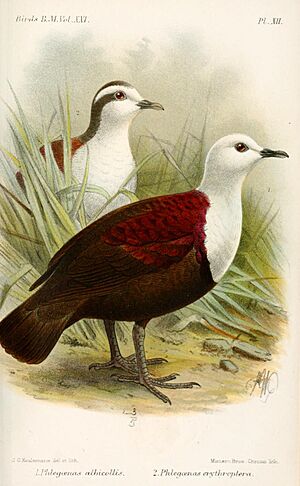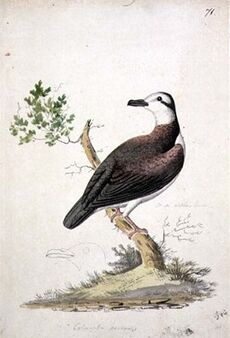Polynesian ground dove facts for kids
Quick facts for kids Polynesian ground dove |
|
|---|---|
 |
|
| Illustration of both the albicollis (left) and erythroptera (right) color morphs by John Gerrard Keulemans, 1893 | |
| Conservation status | |
| Scientific classification | |
| Genus: |
Pampusana
|
| Species: |
erythroptera
|
| Synonyms | |
|
|
The Polynesian ground dove (Pampusana erythroptera), also called the Society Islands ground dove or Tutururu, is a type of bird in the Columbidae family (which includes pigeons and doves). This bird is currently critically endangered, meaning it's at a very high risk of becoming extinct.
It used to live only in the Society Islands and Tuamotus in French Polynesia. However, due to habitat loss and predators like cats and rats, it has disappeared from most of these places. Now, it lives only on the Acteon islands. Scientists believe there are only about 100 to 120 of these birds left.
Polynesian ground doves prefer tropical forests. They especially like areas with Pandanus tectorius and Pisonia grandis trees, and thick shrubs. They have also been seen in dense bushes growing under coconut palms.
Thanks to a project that removed rats from 2015 to 2017, the ground dove has been able to return to Tenarunga island.
Contents
About the Polynesian Ground Dove's Name
The Polynesian ground dove was first officially described in 1789. A German scientist named Johann Friedrich Gmelin gave it the scientific name Columba erythroptera. He based his description on a bird that had been found on Moorea island, near Tahiti.
The name erythroptera comes from old Greek words. Eruthros means "red," and -pteros means "-winged." So, its name means "red-winged."
This dove is closely related to other ground doves, like the white-breasted, white-fronted, and white-throated ground doves.
The Polynesian ground dove is also known by other local names, such as Tutururu. People also call it the Tuamotu ground dove or the white-collared ground dove.
What Does the Polynesian Ground Dove Look Like?
The Polynesian ground dove is a small, round bird that lives on the ground. Male and female doves look different, which is called sexual dimorphism.
Male Polynesian ground doves have white foreheads, cheeks, throats, and chests. Their heads, necks, and ear areas are grey. Their upper bodies are a dark olive grey. They have shiny purple or reddish-brown feathers on their neck and wings. Their lower bodies are blackish.
Female Polynesian ground doves look the same in both types. They are a bright reddish-brown all over. Their heads, necks, and wing feathers have a strong reddish-purple color. Their backs and inner wing feathers are dark olive. They also have a pale shield-like patch on their chest.
Young Polynesian ground doves are mostly red. Many of their feathers have cinnamon-red edges. The white parts of their face and underparts are mixed with grey.
Adult Polynesian ground doves are about 23.5 to 26 centimeters (9.3 to 10.2 inches) long. They weigh about 105 to 122 grams (3.7 to 4.3 ounces). Their eyes are brown, and their beaks are black. Their legs and feet are a purplish-black color.
The call of the Polynesian ground dove sounds like a low, rough moan.
Where Does the Polynesian Ground Dove Live?
The Polynesian ground dove originally lived in the Tuamotu Archipelago and the Society Islands. Sadly, it has now disappeared from the Society Islands, including Tahiti and Moorea.
In the Tuamotus, it has been seen on islands like Arakita, Hao, Hiti, Maria Est, Marutea Sud, Matureivavao, Rangiroa, Tenararo, Tenarunga, and Vanavana. There are also reports that it might have lived on other islands, but no birds were ever collected from them.
These doves used to live on mountainous islands and nearby small islands called atolls. However, when feral cats and rats were brought to these islands, the ground doves disappeared from the mountains. Now, they live on small islands and atolls. They prefer forests with lots of dense bushes, ferns, and grasses. They also live in areas with low, thick scrub and in groves of Pandanus plants.
Polynesian Ground Dove Behavior and Life
The Polynesian ground dove is a shy bird that spends most of its time on the ground. It finds its food by scratching for seeds on the ground. It eats seeds from plants like Morinda and Tournefortia.
Sometimes, it also feeds in trees and bushes. There, it eats buds from Portulaca plants, seeds from Digitaria, and leaves from Euphorbia. When the ground dove flies, it takes off quickly, like a partridge, and its wings make a whirring sound.
Not much is known about how these doves reproduce. However, young doves have been seen in January and April.
Why the Polynesian Ground Dove is Endangered
The Polynesian ground dove used to be very common on most of the islands where it lived. But because it had no natural mammal predators, it was very vulnerable to introduced animals like feral cats and rats.
The ground dove disappeared from most islands soon after Europeans arrived. It's thought that their numbers were already low even before that. Since 1950, the dove has only been seen on two islands. Three birds were found on Matureivavao, and a small group of 12 to 20 birds was found on two islands in Rangiroa Atoll in 1991.
It is believed to be extinct in the Society Islands and gone from many parts of the Tuamotus. However, scientists don't visit these islands very often. Many small islands still need to be explored to see if more ground doves are living there. Also, a survey in the 1970s missed the doves on Rangiroa Atoll. This suggests that other groups of doves might be living on other small islands without being noticed.
Besides the threat from introduced predators, the low-lying islands where the doves live are also in danger from rising sea levels.
Helping the Polynesian Ground Dove Survive
People are working to help the Polynesian ground dove increase its numbers. They are doing this by removing invasive predators and restoring the natural habitats.
On the Acteon islands, which likely have the last healthy population, groups like Island Conservation have worked to restore the habitat. In 2017, their efforts helped the ground dove and the endangered Tuamotu sandpiper return to Tenarunga island. This had not been possible for decades. In 2020, monitoring showed that the population of ground doves was slowly getting better.



